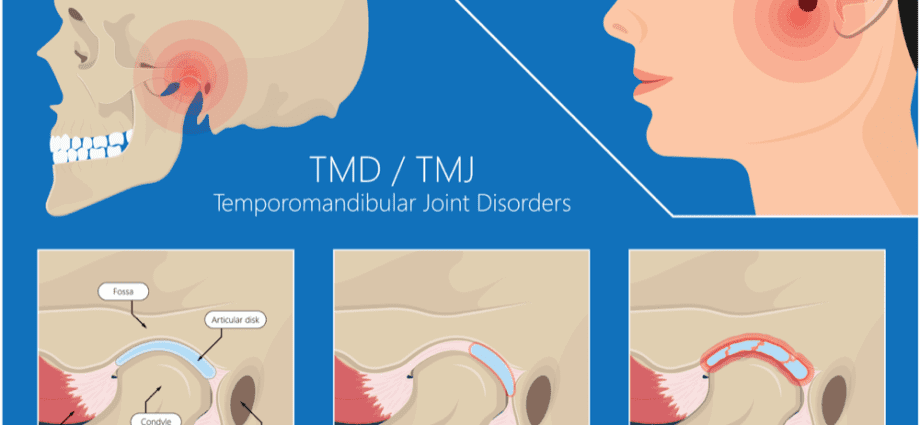Contents
Cracking jaw
Having a cracking jaw: this happens relatively frequently. TMJ disorders, for the temporomandibular joint, are indeed common, and their causes are often multifactorial.
Cracking jaw, how to recognize it
What is it ?
The jaw is made up of two bones: the jawbone at the top, and the mandible at the bottom. The latter is connected at the level of its upper part (condyle) to the bone of the skull (temporal bone) thanks to the temporomandibular joint (TMJ). This articulation located on each side of the face, just in front of the ear, has a fibrocartilaginous articular disc preventing friction between the mandible and the skull bone during the various movements of the jaw (swallowing, chewing, speaking, yawning). When you open your mouth, the condyle turns on itself and moves forward; the articular disc follows the movement by moving forward. Around this joint, different muscles allow the jaw to move in three dimensions: front to back, left to right, bottom to top.
The clicking of the jaw corresponds to a joint noise. It is due to the forward displacement of this joint disc during the opening of the mouth. When the mouth is closed, the disc is no longer interposed between the jaw and the skull; when you open your mouth again, the disc returns to its place, between the condyle and the bone of the skull. The cracking of the jaw corresponds precisely to the passage of the condyle under the articular disc.
How to recognize a cracking jaw
The jaw cracks, slams or squeaks when you open your mouth. It may only be the noise but also the sensation of an element of the jaw “moving”. Rightly so.
This phenomenon can occur in isolation, without any pain or discomfort, or regularly. It can also be accompanied by other manifestations: joint pain in the front of the ear, difficulty opening the jaw wide, headaches, various manifestations in the ear, etc.
Risk factors
Stress can cause, consciously or not, a hypercontraction of the muscles of the jaw which strongly requests the joint and can therefore promote its cracking.
Temporomandibular joint disorders are more common in young women, especially due to hyperlaxity (too loose ligaments).
Causes of a cracking jaw
Bruxism
Bruxism, that is to say the fact of grinding teeth laterally (eccentric bruxism) or clenching the teeth (central bruxism) can cause cracking of the jaw due to overuse of the joint.
A dental malocclusion
Teeth that do not fit together or missing teeth prevent proper placement between the upper and lower jaw, and therefore the optimal functioning of the joint.
A trauma
A trauma or a fracture of the face, especially in the jaw, can lead to lesions of the temporomandibular joint causing cracking of the jaw.
An anatomical abnormality of the jaw
The mandible may be positioned too far back (retrognathia), too far forward (prognathia) or deviated to one side (laterognathia).
A postural disorder
Some specialists believe that jaw disorders are frequently due to postural imbalance. Key joint, the jaw, like a pendulum, could compensate for a bad posture in order to ensure the stability of the head.
Risk of cracking jaw complications
A jaw that cracks regularly can progress to TMJ disorders (temporomandibular joint) also called algo-dysfunctional syndrome of the manducator apparatus (SADAM) or Costen’s syndrome. Linked to a dysfunction of the joint between the temporal cranial bone and the mandible, SADAM manifests itself by a set of symptoms: joint pain when opening and closing the mouth, reduced mobility of the mouth. jaw, headache, cracking, or even jaw blockage. ENT problems are frequently associated: sensation of blocked ears, tinnitus, chronic sinusitis, etc. SADAM can also have repercussions from a distance: back pain, neck pain, pain in the hips, knees, etc.
Ultimately, the risk is that the jaw will lock, preventing feeding.
Treatment and prevention of a cracked jaw
An isolated, non-painful and non-disturbing snap of the temporomandibular joint does not require treatment.
When jaw crunches are frequent, cause discomfort or even disability on a daily basis, and are accompanied by other disorders as is the case in SADAM, management is necessary. Depending on the associated signs and the severity of the syndrome, management may be based on:
- dental care (prosthesis or implant in the event of a missing tooth, for example);
- orthodontic treatment in the presence of a malocclusion or bruxism (wearing a splint at night in particular);
- mandibular physiotherapy, to learn how to relax the muscles of the jaw and swallowing;
- orthognathic surgery in case of bad positioning of the jaw;
- a correction of the posture in the event of postural imbalance.
Manual techniques such as osteopathy can also help, via intra or extraoral manipulations, to remove certain blockages, but also to restore the good general balance of the body.
Since stress is a common cause of jaw cracks, it is important to learn how to deal with it better. For this, different techniques can be used: mindfulness meditation, sophrology, yoga, acupuncture, herbal medicine, cognitive-behavioral therapies (CBT), etc.
Prevention is based on stress management, regular dental care.










